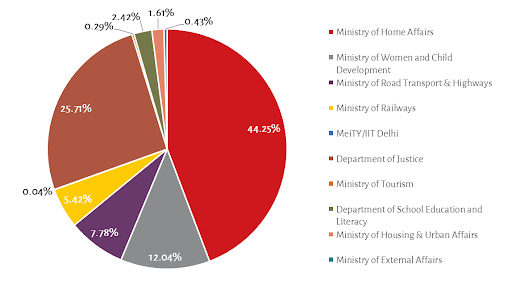
How Funds for Women’s Safety in India have been Under-utilised
17 May 2022
The previous blog in this series explored the under-prioritisation of women’s safety in the Union budget, which manifests through an under-allocation of funds. Fund allocation for the Mission Shakti, an umbrella scheme for women’s empowerment and safety and security, remains dismal compared to other schemes of the Ministry of Women and Child Development (MWCD). This blog looks at the other major challenge of fund utilisation at the level of Union ministries and departments.
The MWCD acts as the pivotal ministry for facilitating projects (or schemes) on women’s safety in India. In the aftermath of the Nirbhaya rape case in 2012, the MWCD, along with the Ministry of Finance (MoF), set up a ‘non-lapsable corpus fund’ called the Nirbhaya Fund[1]. Along with a defined purpose for establishing systems to make public (and private spaces) safe for women, this fund is mandated to finance women’s safety-related projects and schemes across Union ministries and departments, and state governments.
From 2014 to 2021, the fund has consisted of 35 sanctioned projects across 10 ministries and departments. There is a lack of proposals for projects on women’s safety from important ministries and departments, like the Department of Health and Family Welfare, and Urban Development, where convergence for women’s safety is expected (Lok Sabha, 2021; Oxfam, 2021). It is also concerning that existing sanctioned projects reveal critical gaps in spending.
From 2014 to 2021, out of a total of ₹9,549.04 crores, the Ministry of Home Affairs (MHA) forms the bulk of the funds approved for projects under the Nirbhaya Fund (₹4,225.91 crores), followed by the Department of Justice (₹2,455.2 crores) (Figure 1). This, however, seems counterintuitive: If MWCD’s existing schemes on women’s safety face the constraint of under-allocation of funds, which the previous blog explored, why does the Nirbhaya Fund prioritise other ministries’ and departments’ projects on women’s safety over its own ministry?
Figure 1: MWCD only comprises about 12 per cent of the overall funds approved for projects under the Nirbhaya Fund, which correspondingly impacts releases and utilisation[2]

Funds are first approved at the level of the MWCD and MoF, followed by releases and utilisation. Between 2014 and 2021, the MHA (₹2,470.74 crores) and Ministry of Electronics and Information Technology/Indian Institute of Technology Delhi (MeITY/IIT Delhi) (₹3.49 crores) spent all of their released funds. As a whole, however, Union ministries and departments have only utilised 31.31 per cent (₹2,989.57 crores) of the total funds approved for their respective projects.
The MHA, which has complete utilisation of released funds, finds the proportion of fund utilisation to approval (₹4,225.91 crores) at approximately 58 per cent. On the other hand, the MWCD portrays the opposite picture: the ministry has the highest proportion (64 per cent) of released funds (₹736.57 crores) to that approved ( ₹1,149.53 crores). However, it has utilised only over 30 per cent (or ₹217.42) of its released funds.
Therefore, while the MHA has been able to spend its released funds on women’s safety-related projects, the gap in MWCD’s – as the nodal ministry of the Nirbhaya Fund – own spending appears to undermine its role to spearhead women’s safety in India.
These trends are concerning.
MWCD’s under-utilisation of schemes sanctioned against the Nirbhaya Fund is reflected in their corresponding (and respective) low utilisation over the years too (Figure 2). Several schemes – One Stop Centre (OSC), Women’s Helpline (WH), and Mahila Police Volunteers (MPV ) – of the sub-scheme Sambal (under the Mission Shakti) are funded through the Nirbhaya Fund[3].
Figure 2: Utilisation of allocated funds (in proportion, %) of the three schemes echoes the under-prioritisation of women’s safety

Meanwhile, between 2018-19 and 2020-21, OSC has seen a stark downward trend in the utilisation of allocated funds, even though budget allocation for it rose in the same period from ₹105.1 crores to ₹385 crores. With one of the highest reported cases of Crimes Against Women (CAW), Uttar Pradesh, accounting for the most beneficiaries (over 37 per cent[4]) of the total OSC beneficiaries, utilised only over 22 per cent of its total releases from 2018 to 2021.
MPV, on the other hand, saw no funds utilised from its allocation of ₹5 crores for FY 2020-21. Further, states which recorded a significant number of calls under the WH scheme also found no utilisation of funds under it. Clearly, low utilisation points to challenges in scheme implementation and, consequently, achieving the Fund’s core outcomes, which measure systemic changes in women’s ability to report crimes and bring institutional justice to them.
Going forward, ministries and departments, including the MWCD, must take concerted steps to utilise the existing funds earmarked for women’s safety. With the rise in cases of crimes against women in India, ministries must spend effectively and take the country forward in making systems more responsive to the needs of the victims of gender-based violence.
Tanya Rana is a research intern at the Accountability Initiative.
Notes:
[1] The Nirbhaya Fund allows for carrying forward any un- or under-utilised balance from previous financial year(s). Further, the MWCD, as the nodal ministry of the Fund, has constituted an Empowered Committee (EC) for appraising and recommending projects to the Union ministries and departments, and state governments under it. Meanwhile, the MoF only administers the Fund.
[2] MeITY/IIT Delhi forms 0.04 per cent of funds approved out of to the total funds approved under the Nirbhaya Fund till 2021.
[3] Interestingly, other Sambal schemes, such as the Beti Padhao Beti Bachao (BBBP) remain outside of the Fund’s purview. This is intriguing as MWCD’s own classification deems it as a women’s safety scheme, even as funds for other safety-related schemes, such as OSC, WH, and MPV, are raised through Nirbhaya Fund.
[4] The latest figures on OSC beneficiaries can be found here. I calculated the state/UT-wise proportion using these figures.
Also Read: The Status of Gender Budgeting in India





